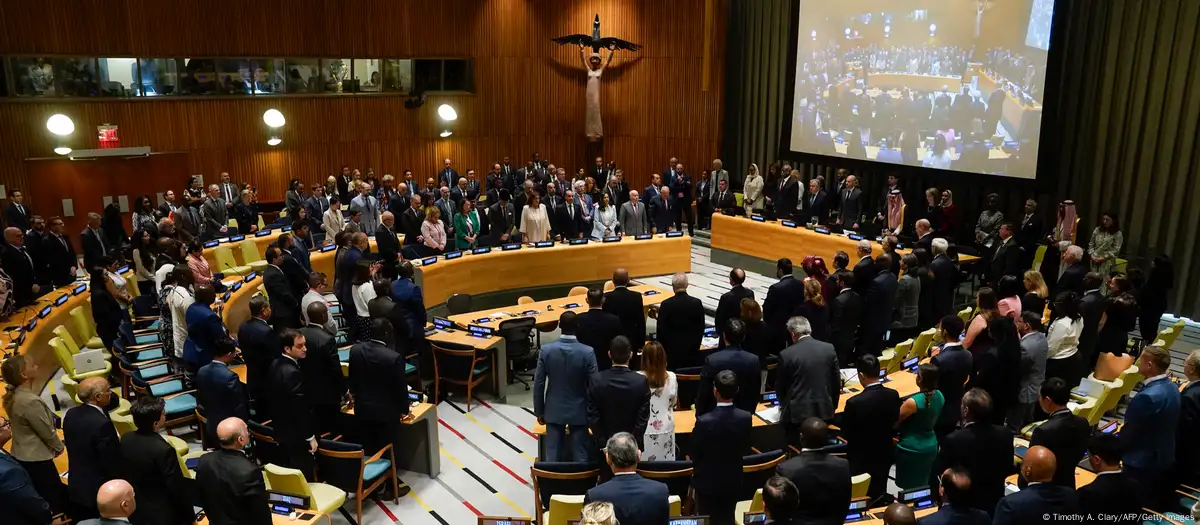
More countries recognize the existence of a Palestinian state. But the way to get this status goes through conventions and disputes – and is rarely easy.
More and more traditional Israeli allies recognize the existence of a Palestinian state or position themselves to do so soon. Palestinian territories – West Bank, Gaza Strip and East Jerusalem, are at the center of the conflict between Israel and Hamas, which runs since October 2023.
France, the United Kingdom, Canada, Portugal and Malta should add to the next General Assembly of the United Nations (UN) to another 147 countries that already recognize a Palestinian state. The group has increased in nine countries since the beginning of the war in the Gaza strip almost two years ago.
If confirmed in September, the change in the geopolitical framework will not necessarily lead to the end of the war, nor will it ensure the layout of clear territorial borders. But the decision is loaded with political symbolism at a critical moment for the region.
“This is a precondition for lasting peace in Palestine and the entire Middle East,” UN independent experts said in June. Israel, in turn, says that the recognition of the Palestinian state would lead to its annihilation and reward terrorism.
Hamas, who rules the Gaza Strip, is considered a terrorist organization by the European Union (EU), Germany, the United States and others.
Brazil was officially recognized a Palestinian state in December 2010, by decision of President Luiz Inacio Lula da Silva, then in the last month of his second term, according to the 1967 borders, before the six -day war.
Who says, after all, what is a state?
The recognition of a state involves great political sensitivity, possible disputes and different criteria to define a country.
One of the simplest guides for the formation of a state is described in the convention on the rights and duties of states, known as the Montevideo Convention and signed in 1933.
The text lists four criteria for the constitution of a state: defined territorial borders, a permanent population, a government that represents the people and the ability to celebrate international agreements. But it does not exhaust the possible scenarios in international politics.
“Unfortunately, recognition remains the weakest part of international law. There is no treaty or regulation on who is a state, who has the right to recognize other states and which entities are candidates for recognition and condition of state,” says Gezim Visoka, a scholar of peace and conflicts at Dublin City University in Ireland.
Some argue that a state exists when it is recognized by enough people outside its own territory, although this is not literally cited in international conventions.
“Recognition is crucial for a state to work internationally, participate in international agreements, benefit from international treaties, protection against annexation, occupations and other forms of arbitrary intervention from abroad,” continues Visoka. “You are in a better position than if not recognized.”
How you become a member of the UN
Today 193 countries are members of the United Nations. But participating in the organization is not a requirement for a state. Countries without full limb status can still act in some functions and join international agencies.
Palestinian territories, for example, are considered a “permanent observing state” while trying to become a full member state. The current statute allows access to most UN meetings and documentation and the maintenance of missions at UN headquarters. But it does not participate in voting or decisions of the Security Council, the General Assembly or the six main UN committees.
Only the Vatican has the same status. Other disputed territories, such as Kosovo and Western Sahara, are not full members, despite having diplomatic relations.
Israeli attacks have been destroying the city of Gaza throughout the conflict started in 2023 | Omar Ashtawy/APA Images/Zuma/Picture Alliance
To become a member of the UN, however, it is not enough to comply with the Montevideo Convention requirements or to be recognized as a state by other countries. The process requires a candidate to follow several steps.
The first of these include a letter to the UN Secretariat General, a formal statement accepting the obligations of a member of the United Nations Charter and the support of the Secretary General.
Then you need to raise the support of nine of the 15 non -permanent members and all five permanent members of the UN Security Council. Today, these countries are China, France, Russia, the United Kingdom and the United States (USA).
This is historically the hardest barrier for candidates, even those with wide international recognition.
When Montenegro and Croatia joined the UN, each had less than 70 recognitions. The Palestinian and Kosovo territories exceed the number and remain from outside the organization.
Once this stage is overcome, the candidate will need to obtain two thirds of the votes of all other UN members in the General Assembly.
In 2024, 143 of the 193 members of the General Assembly voted in favor of a resolution that would recognize the condition of Palestinian state.
The risk of not being recognized
Some states recognized for a long time resisted adherence to the UN. Switzerland, for example, spent 56 years as a permanent observer before finally joining as a full member in 2002.
But the benefits of being part of the UN are clear. Member status serves as a de facto recognition, providing sovereign integrity in case of non -recognition by one or more states and a base for equality, regardless of size or force.
On the other hand, risks to unrecognized states are higher, including exposure to abuse, isolation, unequal business and economic relations and loss of territory.
The definitions happen on a case by case basis. Not all states have unified recognition policies and are therefore subject to improvising, adjusting or changing their positions on the subject.
The scenario of volatility can lead to violence and war as states fight for recognition and legitimacy in the eyes of other nations – such as Kosovo and South Sudan, both fruits of conflict.
Originally published by DW on 08/08/2025
Por Matthew Ward Agius
Collaborated Heloísa Traiano.
Source: https://www.ocafezinho.com/2025/08/09/territorios-palestinos-o-que-define-o-que-e-um-estado/
